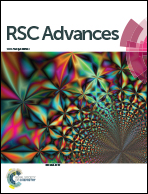Synthesis of Ag nanoparticles decorated MnO2/sulfonated graphene composites with 3D macroporous structure for high performance capacitors electrode materials†
Abstract
An effective strategy to improve the conductivity of MnO2-based electrodes is to combine them with some conductive materials, such as metal or carbon-based materials. In this work, Ag nanoparticles decorated MnO2/Sulfonated Graphene composite with 3D macroporous structure (3D Ag–MnO2/SG) was synthesized and their performance as electrode material in supercapacitors was studied. The improved conductivity and the elaborate design of 3D porous structure allowed the 3D Ag–MnO2/SG electrode to possess enhanced electrochemical performance. For example, the electrochemical testing results demonstrated that the 3D Ag–MnO2/SG presents a capacitance of 537 F g−1 at 0.5 A g−1, which is much higher than that of MnO2 (∼172 F g−1). Moreover, the 3D Ag–MnO2/SG electrode delivers a higher capacity retention rate in high current density and smaller charge transfer resistance than that of MnO2, which is contributed by the synergistic effect from the Ag nanoparticles and the 3D porous SG.


 Please wait while we load your content...
Please wait while we load your content...